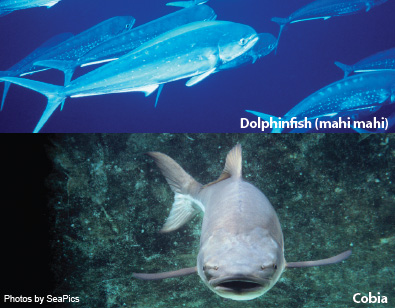Changing the Game: A New Approach to Prevent Overfishing in the South Atlantic
Fishery managers approved sweeping new rules to prevent overfishing and protect dozens of species in the South Atlantic from North Carolina to Florida.
At Stake
New fishing limits cover dozens of species, ranging from the popular dolphinfish, wahoo, king mackerel and cobia, to a seaweed called Sargassum, to little-known corals sold for aquariums. Most of these species had no fishing limits in place. Some have size limits; others have bag or trip limits that restrict the take per fisherman but those rules alone do not adequately limit the overall amount of fish removed from the ocean.
Why It's Needed
The proactive plan is intended to help prevent overfishing by setting cautious limits before some fish populations potentially plummet to critically low levels. The strategy should avert tougher, more painful restrictions in the future by managing fish populations wisely now.
The idea is to avoid what happened with red snapper. The fish is in such severe trouble that a total fishing moratorium was approved in 2010 to save the species. Waiting for a crisis before acting is poor fishery management that has allowed overfishing to deplete too many valuable fish species, including at least 10 in the south Atlantic alone, causing dire economic consequences. This new approach would put fishery managers ahead of the curve. They can better judge when species are declining so they can
act in time. Limits can be adjusted as conditions change.
This strategy also helps address consequences of the red snapper fishing moratorium and additional protections approved in 2010 for about a dozen other dwindling species such as red and gag grouper. Without those species to target year-round, anglers probably will shift their focus to other fish, which could lead to unhealthy population declines. This comprehensive plan takes a big-picture look at fish and fishing, helps avoid problems in the future and sets the course for a healthy, balanced ocean ecosystem.
HOW IT WORKS
Keeping Track
The new system will keep a tighter rein on how many fish are caught. If fishermen catch more than permitted, managers may use a number of methods to keep future catch within permitted levels or make up for the excess, including reducing limits in the short term or establishing shorter fishing seasons. In the past, rules were weakly enforced for fisheries that had quotas and limits were routinely exceeded in some cases. With better control, the limits have a stronger chance of keeping fish populations healthy.

Counting Accidental Catch
In the past, bag, trip or other limits on single fish species have led fishermen to throw back fish after they reached the quota for that species. Fish often do not survive catch and release, and tens of thousands die this way each year. To reduce the deaths and waste of fish, managers may set limits for groups of fish that are often caught together. That means fishermen won't have to throw back as many fish while trying to target a different species.
For example, instead of an allowance of one gag grouper and one black grouper per day, those two species could have a joint limit of two. The limit would not be met until fishermen catch any combination of gag and black grouper. Under the current individual species limits, a fisherman who caught a gag might have to throw back large numbers of gag while trying to get the black grouper. The new system should give fishermen more flexibility and allow them to keep more fish while also maintaining healthy fish populations.
Setting the Limits
Little data exist on some species that will get new limits because it is impossible to count all those fish or study each species. Healthy fish populations and a balanced ocean ecosystem require an overall management plan, however. With some species for which little data are available, scientists have recommended setting limits close to today's average catch with a cautious margin of error to ensure that enough fish remain for a healthy population. In some cases, fishermen probably will see little change.
For other species, determining the limits may be more complex and may mean reduced allowable catch. But as scientists complete more fishery studies, the limits will change to reflect the most up-to-date information and allow as much catch as possible while maintaining healthy fish populations.







